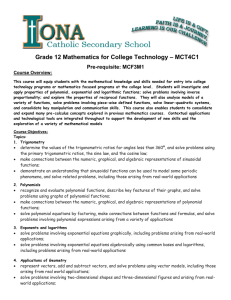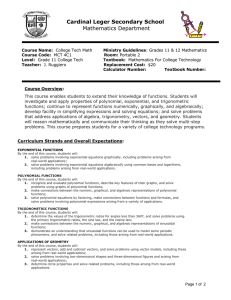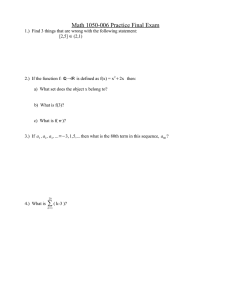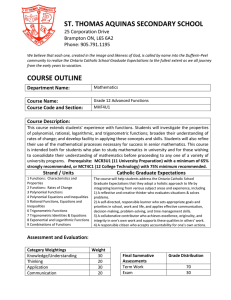Grade 12, College Department of Mathematics St. Edmund Campion Secondary School
advertisement
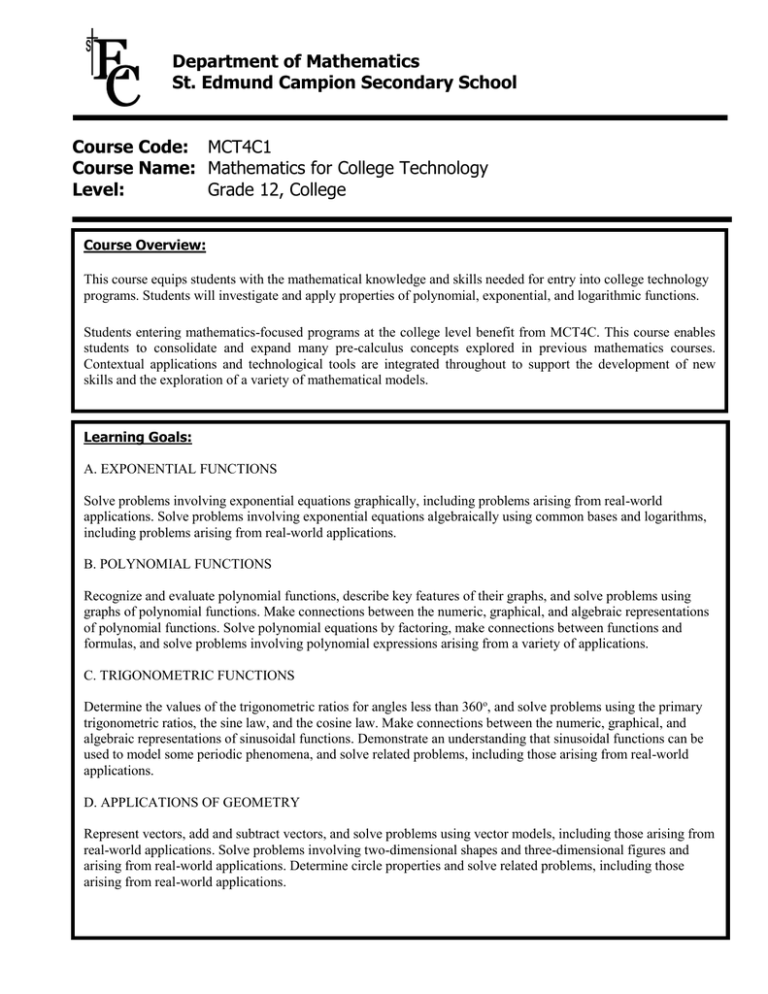
Department of Mathematics St. Edmund Campion Secondary School Course Code: MCT4C1 Course Name: Mathematics for College Technology Level: Grade 12, College Course Overview: This course equips students with the mathematical knowledge and skills needed for entry into college technology programs. Students will investigate and apply properties of polynomial, exponential, and logarithmic functions. Students entering mathematics-focused programs at the college level benefit from MCT4C. This course enables students to consolidate and expand many pre-calculus concepts explored in previous mathematics courses. Contextual applications and technological tools are integrated throughout to support the development of new skills and the exploration of a variety of mathematical models. Learning Goals: Learning Goals: A. EXPONENTIAL FUNCTIONS Solve problems involving exponential equations graphically, including problems arising from real-world applications. Solve problems involving exponential equations algebraically using common bases and logarithms, including problems arising from real-world applications. B. POLYNOMIAL FUNCTIONS Recognize and evaluate polynomial functions, describe key features of their graphs, and solve problems using graphs of polynomial functions. Make connections between the numeric, graphical, and algebraic representations of polynomial functions. Solve polynomial equations by factoring, make connections between functions and formulas, and solve problems involving polynomial expressions arising from a variety of applications. C. TRIGONOMETRIC FUNCTIONS Determine the values of the trigonometric ratios for angles less than 360o, and solve problems using the primary trigonometric ratios, the sine law, and the cosine law. Make connections between the numeric, graphical, and algebraic representations of sinusoidal functions. Demonstrate an understanding that sinusoidal functions can be used to model some periodic phenomena, and solve related problems, including those arising from real-world applications. D. APPLICATIONS OF GEOMETRY Represent vectors, add and subtract vectors, and solve problems using vector models, including those arising from real-world applications. Solve problems involving two-dimensional shapes and three-dimensional figures and arising from real-world applications. Determine circle properties and solve related problems, including those arising from real-world applications. Course Outline: Unit Unit Unit Unit Unit Unit Unit 1: 2: 3: 4: 5: 6: 7: Resources: The course will use a variety of resources that will include computer & graphing calculator technology, and printed resources. The primary textbook Mathematics for College Technology 12 will be distributed to students during the first week of the course. The text and all other resources assigned to each student are the responsibility of the student. Any damage incurred will result in payment for replacement. Trigonometry Sinusoidal Functions Vectors Exponential Functions Polynomial Functions Polynomial Equations Geometry Replacement cost for the text is $75.00. Summative Review & Evaluation Summative Assessment will be administered towards the end of the course and this will include a final examination worth 20% and a culminating task worth 10%. All timelines as stated are approximate. Evaluation Policies 1. Student marks will be determined by evaluating process & product according to 4 categories (see below) & 4 levels of the Achievement Chart as found in the Ministry Policy document for Mathematics. Evaluation Structure:: Knowledge/Understanding Application Communication Thinking/Inquiry 30% 30% 20% 20% Term work = 70% of the final mark. Summative work = 30% of the final mark. 2. Feedback will also be provided for student learning skills. Working independently, teamwork, organization, work habits/homework, and initiative are assessed apart from student achievement in the four categories outlined above and will conform to the coding: E – Excellent G – Good S – Satisfactory N - Needs Improvement 3. Assignments submitted after the due date established by the teacher will receive a penalty in accord with our school evaluation policy as outlined in the agenda. No assignment will be accepted once a teacher has returned marked assignments. Chronic lateness indicates poor organization skills and will result in parental contact and be reported in the learning skills section of the report card. 4. Should a student miss an evaluation due to a legitimate absence, a note shall be provided to the teacher the day of the student’s return to class stating the reason for absence and the parent/guardian’s awareness that the student has missed an evaluation. Makeup will be at the teacher’s discretion. Should such documentation not be provided, a mark of zero will be assigned. May God bless your efforts this semester!

